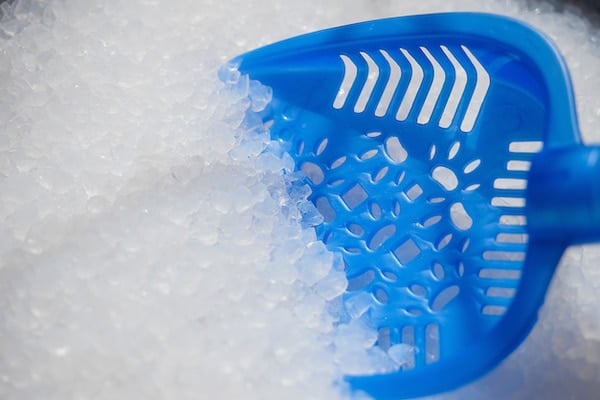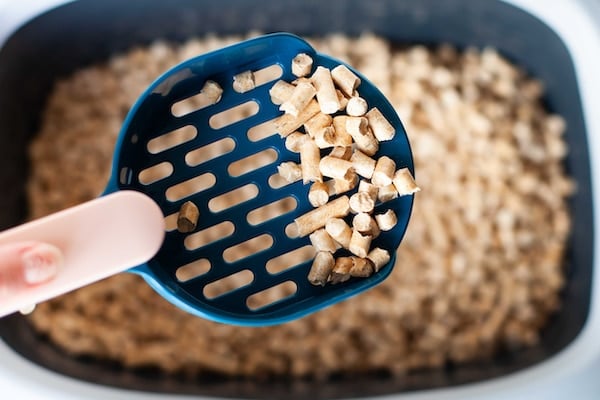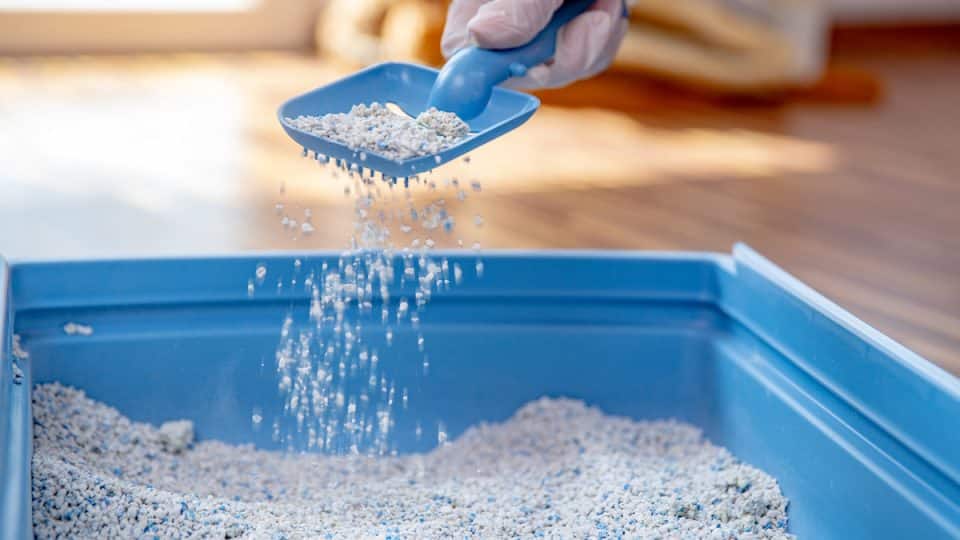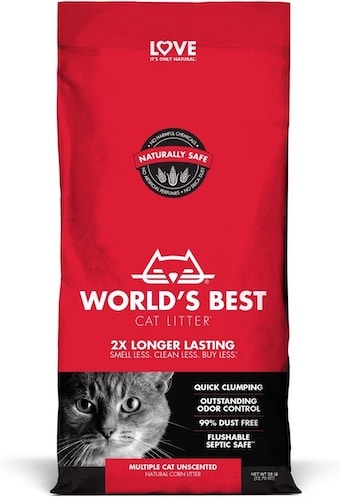- This post contains affiliate links. Read more here.
- This article has been reviewed by a pet health professional. It is not a substitute for professional veterinary advice.
Whether you’re a novice cat parent who’s new to the world of cat litter, or you’re a seasoned pro looking to address a specific need, choosing the right cat litter can be a daunting task. Gone are the days when clay litter was the only option available. Today, the market offers over a dozen types of cat litter, designed to suit different needs.
Some of the new litters are designed for sustainability, others for no dust or lighter trips to the trash can, and yet others to be flushable or monitor a cat’s urinary health. Ultimately, though, it’s your cat who will have the final say.
To help you make sense of the different materials out there—and who they’re likely to benefit—we consulted feline expert Joey Lusvardi, a certified cat behavior consultant and the founder of Class Act Cats. Once you understand how each type of litter functions, you’ll be better equipped to choose one that works best for you, your cat, and your household.
Type of Litter, Explained
Every cat is unique and will have individual preferences when it comes to how they do their business. Likewise, every cat parent will have different needs in mind. Here’s a quick rundown of the most popular litter types.
| Litter Type | Advantages | Disadvantages |
| Clay |
|
|
| Silica Crystals |
|
|
| Pine |
|
|
| Wheat & Corn |
|
|
| Walnut |
|
|
| Paper |
|
|
Clay will be the litter of choice for many cats and cat parents. “Clay litter is the most common litter for a reason: It’s cheap, it absorbs odor well, it clumps, and it’s close to what cats would use in nature,” says certified cat behavior consultant and trainer Joey Lusvardi.
There are some downsides to consider, though. As Lusvardi points out, the dust can trouble cats (and humans) with respiratory sensitivities. It’s heavy, and it has a negative environmental impact, since it isn’t biodegradable.
Silica crystal litter is another popular choice. These clear beads dehydrate solid waste to make scooping easy and absorb urine so all that’s needed is a stir. Though it’s expensive, silica crystal litter lasts up to a month, which can offset the cost. According to Lusvardi, it may suit long-haired cats who need a non-clumping material that doesn’t get stuck in their fur.

Sergey Pakulin via iStock
Finally, there are alternative litters like pine, grass, wheat, corn, walnut, paper, and tofu. They generally shine on affordability, light weight, and eco-friendliness, but the results can be mixed when it comes to cat appeal, absorbency, and odor-control.
Pine and corn, for example, are highly absorbent materials, but they have their own scents that can bother human or feline noses. “While they may help reduce some odor, they do have a pine scent to them, and I have a lot of cats I’ve worked with that don’t particularly like them,” says Lusvardi.
Wheat, corn, and tofu litters are popular for clumping, but if exposed to moisture, they can develop dangerous molds, so you have to store them carefully.
Paper litters take the cake for allergy-prone cats and humans, since there’s almost no dust. They’re cheap and popular with cats—but they’re also not very absorbent, and soggy paper is hard to clean.
Pros and Cons of Each Litter Type
Once you’ve landed on a material, you’ll have to make another set of choices. Most litters come in clumping and non-clumping varieties. You’ll also often see the option for scented and unscented litters, flushable, and even health-monitoring. Here’s what to know.
Clumping versus non-clumping
With clumping litter, it’s all about convenience. “Clumping litter is generally easier to clean up than non-clumping litter as you can scoop more of it out,” says Lusvardi. And because it forms tight clumps, locking odors in the process, it tends to be better for odor control.
However, because it expands when it comes in contact with water, clumping litter can cause issues if ingested. As such, it’s not usually recommended for young kittens who are prone to curious nibbling.
Non-clumping litter is usually more affordable, but you’ll need to change the entire box more often, so the costs are often comparable. Lusvardi also notes that cats with long hair may prefer a non-clumping litter, as clumping litter can get stuck in their fur.
Scented versus unscented
For the most part, experts discourage the use of scented litter. As Lusvardi explains, scented litter is more for the human’s benefit than the cat’s. “Cats have more sensitive noses than we do, so even light scents may be too much for them.”
Even most humans find scented litter off-putting. “Personally, I find the smell of cat urine plus scented litter to be worse than cat urine alone,” Lusvardi remarks.
To eliminate odors, it’s better to scoop frequently, wash bins on a regular basis, and use a litter with either baking soda or activated charcoal.
Flushable litter
Some litters made from biodegradable, plant-based materials are designed to be safe for flushing down the toilet. Commonly flushable litters include wheat, corn, and tofu.
These litters form softer clumps that dissolve naturally in water. Flushable litter will appeal to cat parents for their convenience (it doesn’t get easier than tossing scoops in the toilet) and their eco-friendliness. Not only are formulas like the World’s Best Clumping Corn Litter made from sustainable materials, but flushing them also cuts down on waste in landfills.
However, these aren’t a perfect solution across the board. For one, flushable litter won’t be manageable for all plumbing systems—including older systems, septic tanks, and low-flow toilets. There’s also the risk of introducing parasites into the environment through contaminated cat feces. And some municipalities have restrictions against flushing litter down the toilet.
If your plumbing system can handle it—and your local wastewater authority permits it—flushable litter may be able to streamline your cleaning routine. It eliminates the need for wasteful plastic bags, and it’s convenient for people who live in apartments without easy access to outdoor waste disposal.
Health-monitoring litters
One of the more interesting trends in kitty litter is health-monitoring formulas that change colors to indicate potential health problems like urinary tract infections, bladder inflammation, urinary stones, or blood in the urine. One Rover writer tested the popular color-changing brand Pretty Litter, and noted this could be a valuable tool for concerned cat parents, especially since it can be hard to detect when cats are actually sick or in pain.
However, Lusvardi says the accuracy of these litters is unreliable, and they may lead to false positives—something he’s run into with his own clients. “It seems like they cause a lot of false alarms and unnecessary stress on both humans and felines.”
That said, some cat parents would still prefer to check on a problem that ends up being fine rather than miss something that could get worse. If it puts your mind at ease, a health-monitoring litter could be a good choice.

Natallia Dzenisenka via iStock
What To Consider
There are various factors at play, but ultimately, choosing a litter will come down to first your cat’s preferences, and then your own when it comes to maintenance.
“All litters are going to come with a trade-off, so you need to ask yourself what is most important to you,” says Lusvardi. “Are you okay with a more smelly litter box and more frequent scooping if the litter is better for the environment? Are you willing to pay for a litter that is a bit more expensive but has a better balance of pros and cons from your perspective?”
| Need or Concern | Litters to Consider | Litters to Avoid |
|---|---|---|
| Asthma & Allergies | Low-dust litters like paper and unscented litter | Scented litter and lightweight litters that are prone to dustiness |
| Ease of cleaning | Clumping litter is scoopable, silica litter only requires solids to be scooped, and pellet-style litters are less prone to tracking | Non-clumping litter |
| Low odor | Clumping litter locks in odors, and litters with either baking soda or activated charcoal neutralize odors | Scented litters are irritating and make smells worse, and some plant-based litters may not control odors well |
| Picky cats | Soft, fine-grain litters and unscented litters | Scented litters and litters with hard, rough surfaces (like silica crystals) |
| Kittens | Non-clumping litter is safer if ingested. Kittens may also prefer a softer texture like grass, paper, or walnut. | Clumping litter can cause blockages if ingested. Clay can be dusty and irritate sensitive respiratory systems. |
| Multiple cats | Clumping litter controls odors and makes for easier clean up after multiple kitties | Some plant-based litters may not control odors well enough |
| Environmentally friendly | Most plant-based litters | Clay and silica crystals |
| Long-haired cats | Non-clumping litter, silica crystals | Clumping litter that can catch in fur |
| Post-surgery cats | Paper litter, no-dust litter | Dusty litters risk infection |
What We Recommend
There’s no question that choosing a cat litter can be tricky. If your current litter isn’t working for your cat, you’ll likely see the following signs that it’s time to switch:
- Accidents outside the litter box
- Reluctance to go in the litter box
- Scratching at the litter box from the outside
- Uncovered poop
- Perching on the rim of the box to avoid touching the litter
- Litter caught in your cat’s fur
- Cat nibbling on litter (especially common with corn and wheat litters)
In order to find a new litter, it can help to provide several options in litter boxes scattered around the house. (Short on boxes? Consider briefly switching to disposable, recyclable models.) See which material gets the most use—and which is easiest for you to clean.
Give each test at least a week, and two for good measure, then invest more heavily in the options you and your kitty favor. We’re rooting for you!
How We Chose
The litters featured here were selected based on a combination of our own hands-on testing, a comprehensive look at customer reviews, and an interview with certified cat behavior consultant Joey Lusvardi. We considered a range of litter types that address the unique needs of different cats and cat parents. We’re also guided by the experience of living and playing alongside our own much-loved and strongly opinionated pets, who are never stingy with their feedback.




